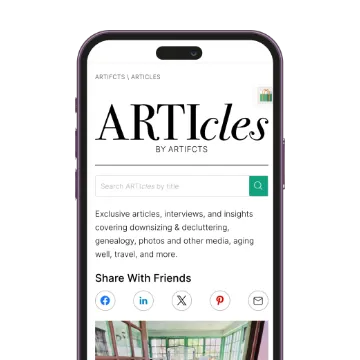We live in a world of information overload, and if you’re digging into family history, that overload threat is potentially multiplied by generations.
Some of us organize our research and learnings in folders, and folders within folders. Nothing other than the name of each folder provides us a clue as to how everything inside relates or where gaps in the content may exist.
Others of us rely on hardcopy photo albums and scrapbooks, often missing the contextual details and stories to bring those books to life when the creator of those books is not there to talk you through them. And how do you modify them once complete?
Whether you’re just getting started with fleshing out your family history or focused on closing gaps, we think timelines are a powerful tool to have in your corner. Dive in with us!
Enriching Family History with Artifcts Timelines
Digital timelines can be hit or miss. Many applications, from Google Photos to specialized genealogy software to Facebook, offer timelines, but they often are rigid in terms of editing and lose the context for each entry. That’s because those timelines simply place photos, for example, in sequential order or display SOME information while leaving other information (documents, photos, ...) in separate, disconnected albums or galleries.
We view the Artifcts timeline as the ultimate way to future proof your history by, first and foremost, revealing gaps in the life moments you've captured with your Artifcts. True story: When our co-founder Ellen first looked at her personal timeline, she realized she’d never Artifcted anything about her wedding! Oops.
Once you know your gaps, you can then create new Artifcts to enrich your history with the stories and memories that have been left out. Another approach would be to start with Artifcts you’ve already created and add in videos and audio and/or supporting documentation for more color and context.
Here's a great example of enriching a family history. It's one thing to know who created this painting:
It’s another to hear first-hand what the artist was trying to capture and what the painting means, a generation later, to the artist’s son. Listen in -->
Sharing family history in bite-sized mini-stories via Artifcts means you make feel-good progress a bit faster and family are more likely to tune in and listen to the whole story.

Put Timelines to Work for You!
As you Artifct, we create your timeline automatically.
Assuming you have created a few Artifcts already, you will find your timeline by visiting your homepage and choosing "My Artifcts." You'll see the timeline option marked with a yellow "New!"
If your timeline is a bit sparse right now, check out the public Artifcts in our founders' timelines for inspiration - @Heather and @Ellen have shared many Artifcts over the past few years.
As you explore Artifcts timelines and think about your family history, test out the built-in timeline features, because you never know from where inspiration may spring:
-
-
- Switch between annual and decade views.
- Flip your Artifcts from newest-to-oldest and oldest-to-newest.
- Drag and drop to move any Artifct to a different year.
- Add time period notes, per year, about key events or family history research gaps.
-
We have great FAQs about timelines and a quick video ready for you as well.
Share with Us
We’d love to hear what you learn about your own history when you look at it anew as a timeline. Had you skipped key life events? Are there whole decades missing? What inspires you to fill in any gaps? You can write to us at Editor@Artifcts.com to share!
Happy Artifcting!
###
© 2024 Artifcts, Inc. All Rights Reserved.

























 Our co-founder Heather and advisory board member Matt Paxton being interviewed for the Inside Photo Organizing podcast.
Our co-founder Heather and advisory board member Matt Paxton being interviewed for the Inside Photo Organizing podcast.  Team Artifcts and some of our wonderful partners enjoying a pizza dinner in Salt Lake City.
Team Artifcts and some of our wonderful partners enjoying a pizza dinner in Salt Lake City. 





